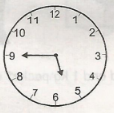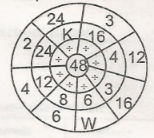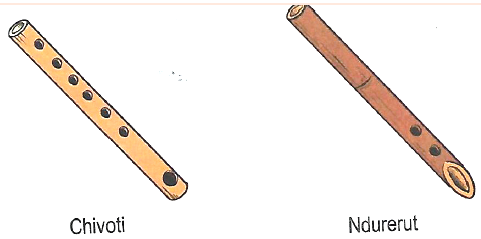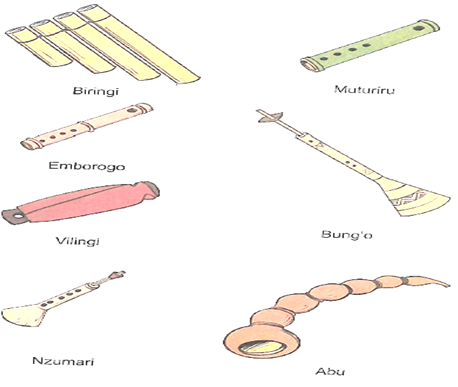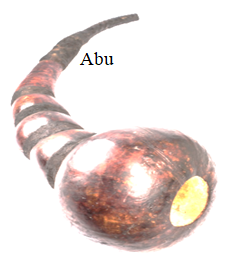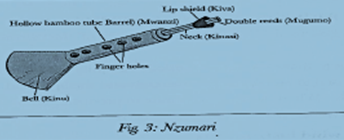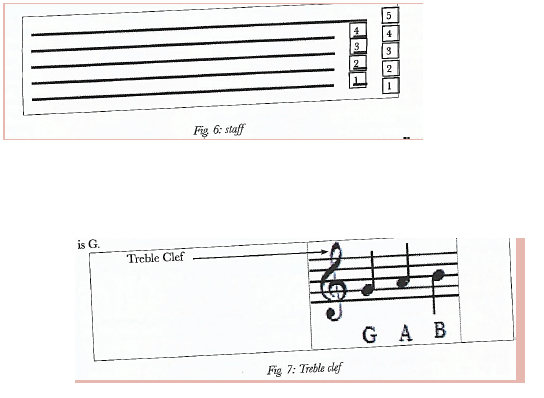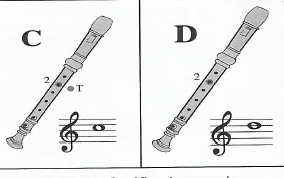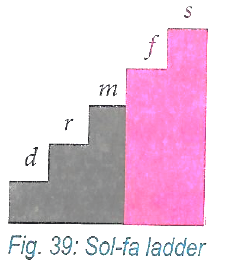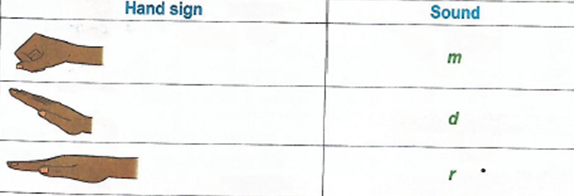Displaying items by tag: grade 5
Science/ Technology/ Agriculture Questions and Answers - Grade 5 End of Term 2 Exams Set 1
- Grade five pupils had put water in different containers as shown below.
They concluded that liquids do not have a __________________________________ - List two poor conductors of heat.
- _______________________________
- _______________________________
- Materials which do not allow any light to pass through them are called ______________________ materials.
- Write three diseases that affect the breathing system.
- ________________________________
- ________________________________
- ________________________________
- List two green non-flowering plants.
- ________________________________
- ________________________________
- Importance of flowering plants.
- ________________________________
- ________________________________
- Name four water borne diseases.
- _________________________________
- _________________________________
- _________________________________
- _________________________________
- Write two laying mammals.
- ________________________________
- ________________________________
- Animals with varying body temperature are called ___________________________________
- Write three signs and symptoms of cholera.
- _________________________________
- _________________________________
- _________________________________
- Muscles that hold the head up and move it in all directions are called ____________________________________
- The 3Rs means:
- ______________________________________
- ______________________________________
- ______________________________________
- Name three internal body parasites.
- ______________________________________
- ______________________________________
- ______________________________________
AGRICULTURE
- A ___________________________ is a place where mature plants grow and are taken care
- Write two reasons for using tools properly.
- ____________________________________
- ____________________________________
- List three materials which can be re-used for gardening in places with little space.
- ____________________________________
- ____________________________________
- Write down three importances of compost manure in the farm.
- __________________________________
- __________________________________
- __________________________________
- List three examples of climbing fruits.
- ____________________________________
- ____________________________________
- Why is a nursery bed raised above the ground? __________________________________
- The process of collecting the deposited top fertile soil from deposition sites is called _____________________________
- Identify the type of soil erosion below
- List two organic wastes used in making compost manure.
- ____________________________________
- ____________________________________
- Write two farming practices that help to conserve water.
- _____________________________________
- _____________________________________
- Write the small animal controlled using the repellant crop below. Onions
- Grade five pupils grouped the following crops in the table below.
- maize
- rice
- cowpeas
- sukuma wiki
- beans
- pumpkin
Cereals Vegetables
MARKING SCHEME
- Definite shape
-
- Plastic
- Wood
- Glass
- Feathers
- Cloth
- Opaque
-
- Cold
- Asthma
- Pneumonia
- Tuberculosis
- Covid-19
- Coughs
-
- Algae
- Mosa
- Fern
- Pine
- Cedar
- Liverworts
-
- Source of food
- Control soil erosion
- Soutrce of medicine
- Source of firewood
- Source of income
- Beautify environment
-
- Typhoid
- Bilharzia
- Cholera
- Dysentry
-
- Duck billed patypus
- Spiny ant eaters
- Cold blooded
-
- Body weaknesses
- Fever
- headache
- Vomiting and wateryDiarrhoea
- Loss of fluids and severe dehydration
- neck muscles
-
- Reuse
- Recycle
- Reduce
-
- Roundworms
- Tapeworms
- Hookworms
- Pinworms
AGRICULTURE
- Garden
-
- Safety measure
- Long lasting
-
- Plastic containers
- Bottles
-
- Reduces waste
- Saves on fertilizer
- Enhances soil quality and nutrients
- passion fruits, grapes, blackberries, kiwi fruits, raspberry fruits and gooseberry fruits.
-
- It is possible to provide favourable growth conditions
- Easy weed control
- Soil recovery/restoration
-
- Splash erosion
- Gulley erosion
- plants materials, animal waste, food remains or kitchen wastes
- mulching, shading, and cover cropping
- Aphids
-
Cereals Vegetables Rice
Maize
Cowpeas
BeansSukuma wiki
Pumpkin
Kiswahili Activities Questions and Answers - Grade 5 End of Term 2 Exams Set 1
KUSIKILIZA NA KUONGEA, KUSOMA KWA SAUTI
Sehemu ya A: Kusikiliza na kuongea
Ningependa tuzungumze kuhusu heshima na adabu. Wewe ni kiranja wa darasa lako una mazungumzo na mwalimu wako wa darasa.
- Anza mazungumzo kwa maamkizi yafuatayo.
(Mwanafunzi ajibu) - Taja maneno ya adabu ambayo kama kiranja unawasisitizia wanafunzi kuyatumia darasani.
(Mwanafunzi ajibu) - Eleza mwalimu umuhimu wa kuwa mwanafunzi mwenye heshima na adabu.
(Mwanafunzi ajibu) - Toa maelezo mafupi vile utakavyoonyesha heshima na adabu kwa mgeni aliyealikwa nyumbani kwenu.
(Mwanafunzi ajibu) - Taja maneno ya heshima na adabu badala ya maneno uliyopewa
- Mtoto anahara _________________________
- Fatuma ana mimba ___________________________
- Halima amezaa ________________________
Sehemu ya B: Kusoma Kwa Sauti
Mama alikumbuka kuwa baba alisahau kumeza dawa. Aliingia chumbani na kutoka na vidonge viwili vya dawa akampa baba aweze kumeza kwa maji. Baba alikuwa na ugonjwa wa kisukari na shinikizo la damu.
Alikuwa anatueleza kuwa ugonjwa wake ulitokana na hali ya maisha katika harakati zake za biashara ambayo ilikuwa mara inapanda mara inashuka. Alikuwa akizinunua bidhaa kutoka Uchina na kuziuza humu nchini. Ingawa aliipenda biashara hiyo, aliichukia hali ile ya ugonjwa na hivyo akaamua kupunguza shughuli zake na kuongeza muda wa kupumzika nasi nyumbani.
Baba alipokata kauli kupunguza shughuli aliendelea kuwa na afya nzuri. Tuliendelea kuzungumza naye mambo aliyofurahia kusikiliza kama vile umilisi tuliokuwa tumepata shuleni. Hasa, alifurahi tulipomwambia tulijifunza kuhusu jinsi ya kuzuia magonjwa. Tulimweleza pia kuhusu magonjwa yanayotokana na hali za maisha kama vile kisukari na shinikizo la damu.
SEHEMU YA A: Ufahamu
Soma kifungu kifuatacho kisha ujibu maswali yanayofuata (alama 5)
Unapotembea mjini, chukua tahadhari kubwa sana. Kuna matapeli wanaohadaa watu mjini. Vile vile matapeli hao hujiweka katika makundi ili kungojea watembezi wanaoonekana wageni. Mara wanapowagundua, wao hunasa pesa, simu na vitu vingine na kukimbia navyo. Pia kuna wale hutumia maneno matamu. Wao hukuandama na ukifika kichorochoroni watakupora na kukimbia. Wengine watakupiga na kukuacha umeumia. Iwapo unataka msaada wowote, basi mtafute bawabu au askari akusaidie. Usijiingize kwenye shida tupu bure.
Maswali
- Kulingana na habari ni watu gani wanaoiba pesa? ___________________________
- Mwandishi anatushauri tufanye nini tunapotembea mjini? ____________________________
- Kamilisha: Maneno matamu humtoa __________________ pangoni.
- simba
- nyoka
- sungura
- mdudu
- Eleza maana ya neno wanaohadaa. _______________________
- Andika maana ya neno 'matapeli ________________________
- Unapofika vichochoroni huwa unafanyiwa nini? ________________________
SEHEMU YA B; SARUFI
- Chagua maneno yaliyopo kwenye mabano kujaza mapengo
____1____.anapenda sana kuogelea majini. Yeye hutaga mayai makubwa makubwa. ____2____ yake ni tamu sana. Kuku pia hutaga _____3_____ japo madogo kushinda va bata. Nyama va kuku pia ni _____4_____ Kuna kuku wa kienveji na kuku wa ______5_______ . Kuku wa gredi huwa na mapato ya juu zaidi. Wao hukua kwa haraka na kutaga mayai ______6______.
( mayai, tamu, nyama, bata, gredi, hukiwa, mengi) - Jaza pengo kwa kutumia viunganishi vifaavyo.
- Juma alikula ______________________ hakushiba. (kwa sababu, lakini, pia)
- Tulipita mtihani _____________ tulifanya bidii. (lakini, na, kwa sababu)
- Halima ________________ Fatuma wanaosha vyombo. (na, lakini, kwa sababu)
- Waliadhibiwa ______________________ walivunja sheria za shule. (pia, kwa sababu, na) (5
- Andika sentensi zifuatazo kwa umoja.
- Miti ya mapera imekatwa.
_________________________________________________ - Nguo zao ni chafu sana.
_________________________________________________ - Viti vizuri vitauzwa.
_________________________________________________ - Wakulima wanalima kwa bidii.
_________________________________________________ - Maembe hayo ni matamu.
_________________________________________________
- Miti ya mapera imekatwa.
- Andika kinyume cha nomino hizi
- Mzee ____________________________________
- Mchana __________________________________
- Maskini __________________________________
- Rafiki ____________________________________
- Mfalme ___________________________________
- Pigia mstari nomino za makundi katika sentensi zifuatazo
- Barabarani kulikuwa na mlolongo wa magari.
- Safu ya milima hupendeza.
- kikosi cha askari kilikuwa kimesimama barabarani.
- Fatuma alinunuliwa jozi ya viatu.
- Mama alinunua pakacha la matunda kutoka sokoni.
- Kamilisha methali hizi
- Mgagaa na Upwa. ___________________________
- Achanikaye kwenye mpini ____________________________
- Mtumai cha nduguye ___________________________
- Tunga sentensi ukitumia maneno yafuatayo.
- Mlindalango
- Vinasasauti
INSHA
Andika insha kuhusu;
JIRANI YANGU
_______________________________________________________________________________________________________
_______________________________________________________________________________________________________
_______________________________________________________________________________________________________
_______________________________________________________________________________________________________
_______________________________________________________________________________________________________
_______________________________________________________________________________________________________
_______________________________________________________________________________________________________
_______________________________________________________________________________________________________
_______________________________________________________________________________________________________
_______________________________________________________________________________________________________
_______________________________________________________________________________________________________
_______________________________________________________________________________________________________
_______________________________________________________________________________________________________
_______________________________________________________________________________________________________
_______________________________________________________________________________________________________
_______________________________________________________________________________________________________
_______________________________________________________________________________________________________
_______________________________________________________________________________________________________
_______________________________________________________________________________________________________
_______________________________________________________________________________________________________
_______________________________________________________________________________________________________
_______________________________________________________________________________________________________
_______________________________________________________________________________________________________
_______________________________________________________________________________________________________
_______________________________________________________________________________________________________
MARKING SCHEME
KUSIKILIZA NA KUONGEA
- Anaendesha
- Ni mjamzito
- Anejufungua
LUGHA
Sehemu ya A
- Matapeli
- Mtafute bawabu na askari
- Nyoka
- Wanaodanganya
- Wezi
- Kukupora
Sehemu ya B
-
- Bata
- Nyama
- Mayai
- Tamu
- Gredi
- Mengi
-
- Lakini
- Kwa sababu
- Na
- Kwa sababu
-
- Mti wa mapera umekatwa
- Nguo yake ni chafu sana
- Kiti kizuri kitauzwa
- Mkulima analima kwa bidii
- Embe hilo ni tamu.
-
- Kijana
- Usiku
- Tajiri
- Adui
- Malkia
-
- Mlolongo wa magari
- Safu ya milima
- Kikosi cha askari
- jozi la viatu.
- pakacha la matunda
-
- Hali wali mkavu
- Halali njaa
- hafi maskini
English Questions and Answers - Grade 5 End of Term 2 Exams Set 1
TASK 1: LISTENING AND SPEAKING
Teacher says: I am going to read for you a story. Listen to it carefully and then answers the questions that follows.
Two children, Fatuma and Malewa, planned to attend a celebration the following day.
Malewa asked, "Tell me more about the celebration tomorrow?"
Fatuma answered, "We shall celebrate Jamhuri Day tomorrow, 12th of December. On this day, we remember the day our country gained independence.
Malewa said, "My teacher said there are more national celebrations in our country. He mentioned Madaraka Day on the 20th of October. I would like to be part of all these celebrations
Questions
- What celebration were the children planning to attend? ____________________________
- Which other national celebration has been mentioned in the story? _____________________________
- What are the names of the children in the story? _______________________________
- Why was the celebration important according to the story? ______________________________
TASK 2: READING ALOUD
"How does cholera spread?' Wawi asked the doctor. "Cholera is a waterborne disease. When water becomes dirty because of pollution, bacteria spread quickly. Unwashed raw fruits and vegetables might also carry germs. Sometimes, farmers may spread cholera when they use contaminated fertilizers," the doctor exlpained.
"It sounds healthy. Hygiene practices would help keep cholera away." Wawi ex
plained.
"Sure," the doctor said. "All of us have a responsibility to keep diseases away. What do you think we can do to keep cholera away?"
"We should wash our hands frequently and clean the environment regularly," Wawi said. "I think we need to get the information to the community as soon as possible. Cholera can kill if it is not treated on time, we don't want an epidemic to break out Cholera con spread like wild firel"
LANGUAGE
Comprehension
Read the following passage and answer the questions.
When the Director of Education visited Mutitu school, she was accomplanied by a few local leaders. She said that even though she had little time, she wanted to talk to the learners about occupations.
She began by asking about their future plans. Few learners raised their hands to answer. The Director said that anyone could become whatever they wanted. She told them that the country had few doctors and plumbers. She said that if they put alittle effort this could change. From the talk, each learner realised they had little knowledge about jobs and occupations.
- Who visited Mutito school? __________________
- The visitor wanted to talk to the learners about what? ______________________
- Who had accompanied the visitor to the school? ____________________
- The Director said that one could become ___________________
- What made the learners realise they had little knowledge on jobs and occupations? __________________
- The _____________________ had few doctors and plumbers.
GRAMMAR
- Complete the following sentences with possessive pronouns
- The mobile phone belongs to me. It is ________________________.
- The puppy belong to the white dog. It is ____________________________.
- The pen I have belongs to Tonny. It is ___________________________
- I think the car belongs to Mrs Kamau. It is _____________________________.
- The house belongs to us. It is _______________________________
- Complete the sentences below with the correct order of adjectives.
- The boys sat on a __________________ mat. (red, traditonal, big)
- Katana drank soup from a ____________________________ bowl. (circular, tiny, new)
- My father bought a ____________________________ table cloth. (triangular, brand new, huge)
- I brought a ___________________________ plate. (big, round)
- Mwangi found a ________________________ pan (round, large, old)
- Complete the sentence using the best occupations
- A person who makes furniture from wood is called ________________________
- A trader who sells vegetables in a market is called ________________________________
- A person who writes books ________________________
- A person who flies on aeroplane is _____________________________
- A qualified person who treats sick animals is called _________________________
- Use degree of adjectives to complete the following questions
Adjective Comparative Superlative- Beautiful _________________ ____________________
- _______________ sweeter ____________________
- _______________ _________________ Eldest
- Fat _________________ ____________________
- Construct accurate sentences using the following vocabulary.
- Rescue _______________________
- Violence _______________________
- Adopt ________________________
ENGLISH COMPOSITION
Write a composition about;
A NATIONAL CELEBRATION I ATTENDED
_______________________________________________________________________________________________________
_______________________________________________________________________________________________________
_______________________________________________________________________________________________________
_______________________________________________________________________________________________________
_______________________________________________________________________________________________________
_______________________________________________________________________________________________________
_______________________________________________________________________________________________________
_______________________________________________________________________________________________________
_______________________________________________________________________________________________________
_______________________________________________________________________________________________________
_______________________________________________________________________________________________________
_______________________________________________________________________________________________________
_______________________________________________________________________________________________________
_______________________________________________________________________________________________________
_______________________________________________________________________________________________________
_______________________________________________________________________________________________________
_______________________________________________________________________________________________________
_______________________________________________________________________________________________________
_______________________________________________________________________________________________________
_______________________________________________________________________________________________________
_______________________________________________________________________________________________________
_______________________________________________________________________________________________________
_______________________________________________________________________________________________________
_______________________________________________________________________________________________________
_______________________________________________________________________________________________________
MARKING SCHEME
Language Activities
- The Director of Education
- Occupations
- Afew local leaders
- Whatever they wanted
- The talk
- Country
Grammar
-
- Mine
- it's
- his
- hers
- ours
-
- big, red, traditional
- tiny, circular, new
- huuge, triangular, brand new
- big, round
- large, round, old
-
- carpenter
- Green grocers
- author
- pilot
- veterinary office
-
- more beautiful, most beautiful
- seet, sweetest
- old, older
- fatter, fattest
Mathematics activities Questions and Answers - Grade 5 End of Term 2 Exams Set 1
- Write the place value of 9 in the number 903456.
- Write in figures. Eight hundred and eighty thousand eight hundred and eight.
- The number of pupils in four schools was as follows. Arrange the numbers from the largest to the smallest.3033, 3003, 3303, 3330.
- Write 23/5 as a mixed fraction.
- 48 is a multiple of 8. Write the next two multiples of 8.
- Round off 809763 to the nearest thousand.
- A class has 42 pupils. Each pupil received sh 425 for buying stationery during the term. How much money did the class receive altogether?
- Identify the angle drawn below.
- Circle all the numbers divisible by 2,5 and 10.
(725, 130, 924,880, 470, 433) - Find the HCF of 24 and 36.
- A farmer sold 3550 eggs in the month of June, 6252 in July and 2042 in August. How many eggs altogether were sold during the three months?
- Calculate area by counting the square.
- Work out:
834527
− 763756
________ - Sheila was depositing sh 4000 everytime she visited the bank. She has sh 16000 in the bank. Write the total amount in the book after every deposit fo five visits.
16000, _______, _______, _______, _______, _______ - Work out;
8/10 − 5/10 = - Work out; 12 − 8 ÷ 4 =
- What is the time on the clockface? ____________
- How many ¼ kg are in 5¼kg of sugar? _________
- Complete the division wheel.
K -
W - - Find the LCM of 10 and 15. _____________________
- Work out;
sh cts
8 5 6
× 5
_______ - Convert 5½ hours into minutes. ______________________
- Fill in the missing number
- Convert 0.33 into a fraction. ________________
- What is the quotient of 72 and 9 ____________________
- A chair costs sh 820. What is the cost of 5 such chairs? ________________
- Allan has 3n apples and Mary has 4f apples. What is the total number of apples they have altogether? _______________
- The price of items in a shop is as follows: \
Halama bought two packets of milk, a loaf of bread and 1 kg packet of sugar.
How much did she pay for the items? ___________________ - A piece of wood 31m 38 cm long was cut into 6 equal pieces. How long was each piece?
- Write the next number in the pattern below:
5,7, 11, 17, 25, _____________
MARKING SCHEME
- Hundred thousands
- 880808
- 3330, 3303, 3033, 3003
- 43/5
- 56, 64
- 810000
- sh. 17850
- Obtuse angle
- 130, 880, 470
- 12
- 11844
- 42
- 70771
- 20000, 24000, 28000, 32000, 36000
- 3/10
- 10
- 5:45/ Quareter to six/45 minutes past five
- 21
- K - 8
W - 2 - 30
- Sh 42 80cts
- 330min
- 16
- 33/100
- 8
- 4100
- 3n + 4f
- 250
- 5m 23cm
- 35
Listening, Responding and Appreciation - CBC Grade 5 Music Revision Notes
Element Of Music
The following are musical instruments
Pitch – the highness or lowness of sound. The combination of varied pitches produces a melody e.g pitch pipe
Melody – should be done keenly as it is difficult to correct once mastered. Use melodies or songs familiar for the start.
Dynamics – relates to the volume of sound. This can either be loud or soft. Dynamics influence the expressiveness in a performance.
Beat /Pulse – regular through of music. The following activity helps in identifying beat.
- Clapping/tapping
- Chanting the words of familiar songs rhythmically
- Conducting learners
Tempo – refers to pace or sped of music.
Activities such as clapping, tapping, marching can be use when teaching about tempo
Responses to tempo are communicated through by running, walking jogging, or skipping.
Mood- this involves feeling about the songs, whether happy or sad
Form – is the structure or shape of piece of music, it is dictated by the melody. The rhythms and repetition on the piece
It is always shown with letters such as //A// OT //B// or //AB//
Grade 5 focuses on //ab//. The part is always the stanza while the B part represents the chorus.
Christian Living - CBC Grade 5 CRE Revision Notes
- Friendship Formation
- Human Sexuality
- God: The Source Of Life
- Good Health Practices
Friendship Formation
- This is the process of making and maintaining friends.
- Friendship is an integral part of human life because human beings are social beings.
- There is a need for people to be very careful on how they choose their friends.
Peer Influence
- Peer influence is the effect your friends or age mates have on your behavior.
- We should be keen when choosing friends since they influence our behavior. Bad friends and groups can ruin our lives.
- Peer influence is the strong pressure to an individual to adopt the attitude, values, behavior and thoughts of his or her peer group.
Qualities Of A Good Friend
- Read 1 Thessalonians 5:11 and Galatians 6:2.
- Friends should help one another.
- A good friend should encourage his or her friends.
- Friends should help carry one another’s burdens.
- He should be caring.
- He should be loving.
- A good friend should be truthful.
- He or she should be kind.
- He or she should be compassionate.
- Should be one who is humble.
- A good friend should be respectful and responsible.
Values Useful In Maintaining Good Friends
- The useful values in maintaining good friends are;
- Honesty, trust, caring, obedience, respectful, selflessness, kindness, truthful, loving, peace, thankfulness, humility.
Causes Of Poor Choice Of Friends At Home And School
- Low self-esteem.
- The desire to prove oneself to others. Lack of proper role models to emulate. Failure to obey the school rules.
- Failure to obey God’s commandments.
Good Friendship
- Teaches us how and when to forgive.
- Help us deal with stress.
- Help us during our difficult times.
Human Sexuality
- Adolescence is a developmental stage in life. The developments are both physical and emotional.
- Adolescence is the period during which children grow from childhood to adulthood.
Changes Associated With Adolescence In Boys And Girls
Physical Changes In Boys
- Shoulders widen.
- Chest broaden.
- The voice breaks.
- Growth of pubic hair.
- Oily face.
- They sweat a lot.
Physical Changes In Girls
- Body increases in size and shape.
- Breasts grow.
- Waist and hips become more obvious.
- Menstrual flow starts.
- Growth of pubic hair.
- Face tends to be oily.
- They sweat a lot.
- Emotional Changes during adolescence are changes of the feelings other people or situations. These changes include mood swings, stress, irritations or getting easily upset.
How To Cope With Body Changes During Adolescence
- In case one experiences these changes, he or she should report to the parent or guardian, teacher or a trusted adult for moral support and advice.
- Adolescents need to accept these changes, as it is part of growth. It is how God created every human being.
- It is important to get the right information about adolescence in order to understand and handle the stage the right way.
Healthy And Unhealthy Boy Girl Relationship
- Read 1 Corinthians 6:18-19.
- A healthy boy girl relationship is one that has mutual respect, trust, honesty, understanding, role models, and good communication. Activities that show a healthy boy girl relationship include playing together, studying together, cleaning together, respecting each other.
- An unhealthy boy girl relationship has bad behaviours and mentality, lacks self control, negative influence, dishonesty and disrespect.
- Our body is the temple of the Holy Spirit and we should take care of it since it was given to us by God to use to glorify Him.
- We should not commit sexual sin.
Effects Of Unhealthy Boy-girl Relationship
- It can lead to early pregnancies.
- It can also lead to school dropouts.
- Unhealthy boy girl relationship can make us feel bad and unhappy about ourselves.
- It can also hurt our bodies.
- It lowers our dignity and self-esteem.
Overcoming Unhealthy Boy-girl Relationship
- In order to achieve this, we should;
- Get good friends who respect you.
- Keep yourself busy in constructive activities.
- Read the bible.
- Focus on the qualities you would want to have in a friend.
- Be assertive.
- Meet with the opposite sex in open place
- Ask your guardian or trusted adults for advice.
God: The Source Of Life
- Human life is given by God.
- No one has the right to take it away. Life is holy and sacred.
- It is God alone who has the right of taking life away.
Christian Teachings On God As The Only Source Of Life
- Read Genesis 1:27, Genesis 9:6, Psalms 49:7-8.
- Life is a gift from God.
- God created human beings according to Genesis 1:27.
- Psalms 49:7-8 teaches us that payment for human life is too great and can never be paid enough.
- We should protect life.
- Human life is made in the likeness of God.
- We should say NO to substance abuse and sex.
- We should inform our parents if we are sick.
- We should avoid playing dangerous games.
Causes Of Violation Of Human Life
- The right to life is the belief that a being has the right to live and should not be killed by anybody.
- God created human beings so that they would live. The causes include;
- Anger.
- Bitterness.
- Selfishness.
- Poverty.
- Depression.
- Alcohol and substance use.
- Not seeking medical help when sick.
- Inability to tolerate other people’s religion.
- Being biased against gender and ethnicity.
- We should raise awareness about avoiding the violation of right of life through social media or posters.
How To Cope With Emotions And Stress
- Emotions are strong feelings we have.
- Stress is a state of mental or emotional strain.
- Stress can cause different emotions. For example fear, anger, sadness or frustration.
Ways Of Coping With Negative Emotions
- Discuss with a friend or guardian. Praying to God.
- Reading the bible.
- Sing a song that makes you feel happy or joyful.
Good Health Practices
- It is our duty to maintain good health.
- A drug is anything that if taken, alters the normal functioning of the body.
Alcohol And Substance Use
- It is the use of alcohol and other harmful substances for enjoyment.
- Harmful substances include miraa, glue, tobacco, bhang e.t.c
- Reasons why young people engage in alcohol and substance use.
- Peer pressure.
- Bad company.
- Curiosity.
- Idleness.
- Technology.
- Depression.
- Stress.
- Low self-esteem.
- Bad role models.
- They feel misunderstood.
- Failure to find a trusted confidant for their frustration.
Effects Of Alcohol And Substance Use To The Body And Relationships
- Read Proverbs 20:1, 31:6 and Ephesians 5:18.
- The bible teaches us not to drink because drinking makes us loud and foolish.
- They only ruin us.
- They make us suffer.
- Breathing problems especially as a result of smoking.
- Liver and kidney problems resulting from alcohol use.
- Negligence.
- It can lead to physical abuse.
- Financial troubles.
- Heart related problems.
- High blood pressure.
- May lead to stroke.
- Can lead to unhealthy relationships among family members.
- Affect one’s success in school.
- Can lead to physical injuries.
Ways Of Avoiding Engaging In Alcohol And Substance Use
- Say NO politely to friends who use.
- Take a walk for relaxation.
- Play a sport.
- Avoid bad company.
- Keep busy through studies.
- Engage in daily chores and productive routine.
- Pray for strength to evade temptations.
Appropriate Use Of Social Media
- Social media is used to keep in touch with friends. It is also used to educate and keep us informed.
Meaning Of Social Media For Awareness
- Social media are forms of electronic communication through which users create online communities, share information, ideas and personal messages.
- Uses of social media include;
- Search for information.
- For learning and studies.
- To communicate with family and friends.
- For entertainment.
- Social media commonly used today include;
- Facebook.
- Twitter.
- Youtube.
- whatsApp.
- WeChat.
- Instagram.
- Viber.
- Telegram.
Effects Of Appropriate And Inappropriate Use Of Social Media
- Appropriate use of social media enables one to get information he or she needs.
- It also enables one to save time.
- Inappropriate use of social media may lead to negative influence.
- It also causes time wastage.
- Cyber bullying is the use of electronic communication to harass a person by sending them negative or threatening messages
Advantages Of Social Media
- It is used for communication with family and friends.
- It is used for getting information.
- Used for getting knowledge and learning.
- It can also be used for entertainment.
Disadvantages Of Social Media
- It reduces face to face communication.
- It may lead to negative influence.
- It causes anti social behaviors.
- It may reduce family closeness.
- Some of its contents are inappropriate for children.
Safety Measures To Observe When Using Social Media
- For security and safety, we should not share our personal information on social media.
- Avoid spending a lot of time on social media.
- We should not trust all the information displayed on social media as some information may be misleading.
- Report any form of cyber bullying to the authority.
- Avoid sharing your passwords.
- Avoid accepting friend requests from people you do not know.
- Observe politeness even on social media.
- Secure your social media accounts and information using passwords and security pins.
Kenya Indigenous Musical Instrument - CBC Grade 5 Music Revision Notes
Wind Instrument
- They are also called aero phones. They are played by blowing
These instruments have a permanent tuning which is acquired during construct - This is because upon constructions, wind instruments remain of fixed length, have a fix number of holes and a fixed blowing hole.
- They vary in shape, size and material used to make them. They are grouped in the following sub- classes”
- Horns- made from animal horns or natural hollow or hollowed out wooden tubes. Among some communities horns are joined to a gourd. E.g.
- Oluika- luya
- Lalet-kalenjin
- Oporo/tung’-Luo
- Coro-kikuyu
- Kikundit-kipsigit
- Adet-turkana
- Aluti-Teso
- Flutes-Are made from materials such as bamboo, swamp reeds, twig or wooden tubes. Currently improvised using plastic tubes.
Flutes vary in length and number of finger / pitch holes from one community to another.
Other features that can be used to distinguish or differentiate flutes are:
- closed at both ends
- Open at both ends
- Open at one end and closed at another end
- Notched at the blowing end (part of the end is v-shaped)
- Round at the blowing end
- End blown (also oblique)
Side blown (also traversely blown-this means the blowing hole is at the side of the flute.)
Indigenous flutes from the diverse Kenyan communities include:
End blown flutes (oblique)- Muturiri-Gikuyu
- Auleru-Teso
- Asili/Odundu-Luo
- Ndererut-Kalenjin
- Ebune/Elamaru-Turkana
Traversely held flutes - Chivoti-Digo, Rabai, Duruma
- Ekibiswi-Kuria
- Emborogo-Kuria
- Umwere-Kuria
- Mulele-Luhya
- Whistles – these wind instruments are made from hollow tubes or reeds which are bound together. The different length makes it possible to produce different varied pitches when the instrument is blown e.g. biringi of Agikuyu, vilingi of the Akamba.
- Reed instruments – double reed instruments have two reeds at the mouthpiece which is made from reeds. The two reed instruments have a tip shield made out of a coconut shell of metal coin
The lip shield- holds the reed in place and prevents air from escaping. The reeds vibrate when air is blown into the instrument thus producing sound. The Nzumari and the Bung’o played among some of the mijikenda community such as Digo and Rabai.
Functions of parts of flutes
- Bamboo reed - this is the main framework of the instrument and it also serves as the resonator
- Blowing hole – it is a hole through which air is blown causing the production of sound
- Pitch hole – are closed and opened with alternating finger movements to produce varied pitch when playing the melody.
- Closed – end = this part direct the sounds towards the open end.
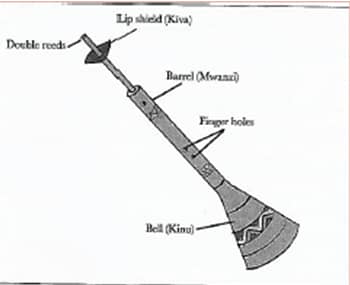
FUNCTIONS OF THE PARTS OF REED INSTRUMENTS
- Hollow bamboo reed – this is the main body of the instrument which act as a resonator
- Bell - it is used to make the sound louder or amplify the sound
- Neck - use to attach the double reeds and the lip shield
- Double reeds - when blown, they vibrate to produce sound
- Lip shield – this is where the lip rest when blowing
SKILLS OF PLAYING WIND INSTRUMENTS
- Some are held traversely while others are end blown
- Positioning of the lips – the lower lip is placed on the lower part of the blowing hole
- Blowing- air should be blown across the blowing hole. The amount of air being blown depends of the wind instrument.
- Tonguing - the tongue is used to put the accent on
- Fingering – closing and opening of finger holes in an alternating manner assist to produce varied pitch.
- Breath control – it’s also referred to as phrasing and should be done at appropriate places when playing the wind instrument.
Western Musical Instrument
Descant Recorder
Recorder fingering chart
Skills of playing the recorder
- Posture – correct poster will help in breathing deeply in order to get good sound out of the recorder.
- Breath control – enables them to achieve the good phrasing when playing the descant recorder.
- Holding – should be held properly with both left handed and right handed learners. The recorder is end blown.
- Embouchure - refers to the position and the use of the lips and teeth in playing wind instrument. It includes shaping the lips to the mouthpiece of the musical wind instrument
Embouchure is important because it affect the production of quality of sound - Articulation – (preparing the tongue) air flow is critical to the production of good tone or sound on the descant recorder. Blowing too much air will leard to production of squeaking sound.
- Fingering – the left hand should be placed in the first three holes, while the right hand should be placed in the rest of the holes. Holes should be covered completely, failure to which will cause air to escape and a squeaking sound will be produced.
When holes on the descant recorder are covered completely, small round marks will be imprinted on the fingersTHE NOTES B, A AND G
They are played using the left hand and are organized logically with fingers moving in a sequential order.
Music Staff Notation
THE STAFF- this is a set of five parallel line and four spaces on which music is written.
The lines and spaces are named using the seven letters of the English alphabets A,B,C,D,E,F, and G.
Naming is made possible using clef. The treble or G clef is used to establish the pitches of the staff
Music for the descant recorder is written on the staff using the treble Or G clef.
Fingering notes is illustrated below
NEW NOTES C AND D
- They are fingered using the left hand as shown below
- The left hand thumb hole is left open when playing the note D
Kenyan Folk Dances
Dance - a form of art involving rhythmic movement’s f the body in response to music
It is an expression of norms, values, belief, attitudes and customs of the community.
In traditional African society dances are for specific groups of the performance e.g. boys, girls, boys and girls, young women and
Categories of participants
- Soloist – introduces dances, it is also known as Solo choral response or call response singing.
Roles of a soloist- Starting the dance
- Ending dance
- Help capture the message and the mood of the dance
- Pitching the dance songs
- Cuing dance on the change of melodies, movements and dance formations.
- Dancers – perform dance movements, create formations
- Dancers – perform dance movement. create formations
- Lead dancers – remind dancers the next dance style and formation. Guide other dancers in creating the varied dance styles/movement and formations to ensure transitions to ensure transitions are smooth.
- Singers - respond to the call of soloist. Make performance lively. Communicate the message and the mood of the dance
- Instrumentalist – make the dance performance lively.
Melodic instrument helps in pitching the performance.
Help in keeping the steady beat of the songs.
Assist to cue singers and dancers on the change of melodies, dance styles and formations to ensure smooth transition.
Provide rhythmic and melodic support to the rhythms and melodies in dance. - Audience and onlookers – make participants feel appreciated
Their participations bring the dance to life
Costumes
This involves styles of dress or clothes worn by the participants in dance performance. Roles of costumes in dance performance include:
- To depict the cultural community it is drawn from.
- To adorn the participant
- To distinguish the different roles played by various participants of the dance
- Influence the participant level of confidence
- Allow dancers or the wearers freedom of movement and formation
- Give information about certain role or characters due to elaborate details of the costumes
- They give the participant of the dance aesthetic appeal
- Are associated with the costumes and habits of a group of people
- Gives the participant dignity
- Help the identify the community the song originates from
- Create uniformity among the participant
- In modern times dance performance use uniform costumes made of sisal and banana leaves
- In each community there are items of value which the participants use during dancing. These items are also known as artifacts which includes shields, swords, skis and traditional tools.
Body Adornment
- It is an art which involved decorating the body, these vary across communities and can be permanent or temporary
- Permanent body adornment is done by piercing, scarification or tattoos, both are used to enhance beauty and also have social and ritual significance
- Some adorn using temporary designs using pain, ochre and henna to decorate the skin. The decoration can symbolize a variety of meaning e.g. social, economic or marital or even political status of the wearer.
- In some communities it is used to enhance the feminity or masculinity of an individual.
- The most common method used nowadays is by water emulsion pain
The type of body adornment used is influenced by the occasion /event or an individual’s stage in life.
Ornaments
Are accessories, articles or items used to add beauty or decorate the appearance of the participants in dance.
In some communities’ beadwork is an integral part of making ornament, beads used in making ornaments can vary in shape, size and colour. The ornaments include.
- Earring
- Armlets/armbands
- Anklets
- Necklaces
- Feathers
Creating /composing
Is a succession of sound with long, short or equal duration. It is the pattern of the music in a given time. It can exist without a rhythm.
The long and short the French rhythm names are used to create different rhythms and represented by different matching symbol. These musical symbol are the musical notes.
| French rythm name | Length of sound |
| Taa | 1 long sound |
| Ta-te | 2 long sounds |
| Taa-aa | 2 long sounds |
| Taa-aa-aa-aa | 4 long sounds |
| French rythm name | Note symbol | Note name | Length of sound | Number of beats |
| Taa | |
Crochet | 1 long sound | 1 beat |
| Ta-te | |
Quavers | 2 long sounds | ½ a beat for each quaver |
| Taa-aa | |
Minim | 2 long sounds | 2 beats |
| Taa-aa-aa-aa | |
Semibreve | 4 long sounds | 4 beats |
Words have their natural speeches style which dictates whether to be given either along or a short beat. Syllables in words can be stressed while others are not.
The stressed syllables occurs as strong beats while the unstressed syllables as week beats.
The beats are divided into groups of two beats, three beats or four beats
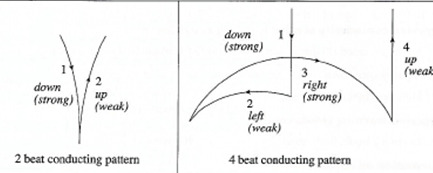
Melody
Is a sequence of pleasant sounds that makes up musical phrase
It is a tune that sound nice or pleasant to the ears
An understanding of high and low sounds is essential in identifying melodic variations within a song. Variation to simple melodies can be created by
- Repetition
- Changing doh
- Changing rhythms
- Changing note
- Changing words
Hand Signs
It is a good way of understanding and recognizing pitch. These are gestures used to indicate pitch in sol –fa.
When using hand gestures to guide the pitch of the ‘’doh’ is movable (it is not fixed)
Hand signs showing sol-fa syllables
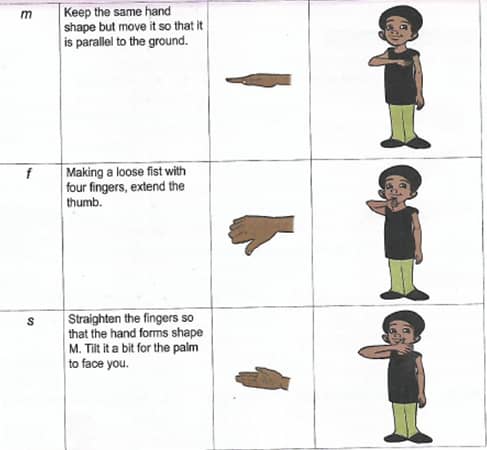
Hand signs showing sol-fa syllables
Performing - CBC Grade 5 Music Revision Notes
Songs
Repertoire - This is a wide collection of songs. It varies in language, events or occasions and activities relevant to the learners.
There are various categories of songs to be learnt in Grade 5
They include
- Religious songs
- Patriotic songs
- Topical songs
- Popular songs
The criteria for choosing songs should include
- Simplicity in text and, rhythm and melody
- Stepwise movement of melodies
- Call and responsorial.
- Songs with catchy appealing melodies.
- Strophic infrastructure (songs with different verses which are sung to the same music).
- Full appropriate activities / actions for the learners.
Types of Songs
- Patriotic songs – They are sung in praise of a county and its leaders. They emphasize on patriotism and social cohesion eg Kenya, Kenya Taifa Leo.
- Topical songs – they are used to convey special message on pertinent and contemporary issue. These include safety, personal hygiene, health and nutrition, importance of education environmental conservation and values. Corona Ni Atari, wash your hands.
- Religious / sacred songs – They are imposed for religious purpose e.g. Christianity, Islam and Hinduism use their sacred songs to worship and praise a divine.
- Popular songs – They have great appeal to listeners. Such songs cause an audience to easily dance or sing along. The lyrics. Rhythm, melody or genre can influence the popularity of the songs.
The East African Anthem
- It is also known as wimbo wa Jumuiya ya Africa Mashariki in Kiswahili
- It has three verses which are sung in Kiswahili
- It is also commonly or simply referred to as EACA (EAST AFRICAN COMMUNITY ANTHEM)
- The anthem is sung among the east African community members states namely: Kenya, Rwanda, South Sudan, Tanzania and Uganda.
- The music of EAC anthem is presented in two scores namely:
- A choral music score written for Soprano, Alto ,Tenor and Bass
- Brass band music score written for the western brass musical instrument.
- In grade 5 it is limited to being sung in unison using Soprano melody.
- It is to be sung once the East African Communities has been hosted in all government and public learning institutions in Kenya.
- Both the Kenya National Anthem and the EACA should be performed at public events with the aim of boosting the East African Community integration and also as a symbol of unity among the East African community member states.
Guidelines of Performing the EACA
- During and the occasion of the performance, everyone present should stand to show a sign of respect.
- EACA citizens shall sing or play the anthem during the occasions or regional significance.
- Individuals playing or singing the EACA should ensure that the tune and the lyrics (words) are sung with the dignity it deserves.
- Either the instrumental or sung version will be performed.
Occasions during which the EACA is performed
- During all the EACA summit meeting and commemoration days.
- During any occasion of the community where the head of the state is present, two verses of the anthem shall be sung or played
- Any other occasion
Skills and concepts to be developed in singing
Accuracy in pitch, rhythm and words should be observed while singing the various types of songs.
Learners should observe the natural speech rhythm of the words of the songs which define the rhythmic pattern of the songs
PART SINGING
There are indicators to show that learners are ready to sing in parts, they include:
- Singing in tune and unison without support of either the voice or instrumental accompaniment.
- Accurate imitation of melodic phrases and phrases and rhythmic patterns.
- Confidence while singing alone with others.
Questions
- Name three types of songs?
- Write occasions when patriotic songs are performed?
- When should the East African Community Anthem should be sung in Kenya?
- Write the Kenya National Anthem verse 1 in Kiswahili?
- Name any three voices in a three part song?
Kenya Folk Songs
- Singing is part and parcel of everyday life in any community. This habitual practice is deeply embedded in every cultural activity within the community.
- It plays and integral part in ritual and social event within a community.
- Folk songs are songs sung in particular community.
- It originates among the people of particular are or locality.
- They are sung in the local dialect or language of the community they originates from.
- The songs are handed down from singer to singe or from one generation to another by oral tradition
- Folk song starts at welcoming of birth once new born baby takes the first breath.
- As an individual, he or she celebrates rite of passage which introduce them to adult responsibilities as captured in work songs, wedding songs, initiations songs, praise songs and when an individual dies, dirges (funeral songs)
- The circumstance/events/occasions within which the folk songs are performed dictate the message, gender and aged of the participant.
- Folk songs tell stories, give a snippet of the past life and highlight various areas of life shared across the cultures and shed life don similarities between people.
Folk songs serve the following roles
- Preserves community culture
- Define cultural identity/helps to distinguish one community from the other.
- Used as a medium of communication
- Enhance or strengthen unity or solidarity within the community.
- Enhances conformity to social norms of the community.
- Creates/provides a medium forum of emotional expression
ASPECT OF FOLK SONGS
- OCCASIONS
life is punctuated by different events or occasions. The events are influenced by community tradition, customs and history e.g ritual and social occasions such as birth of baby, work, marriage, funerals initiations and religious ceremonies. Each occasion has its own special song. - MESSAGES
Folk songs play a communicative role. The various occasions dictate that the song sung have messages that are appropriate to the ceremony or event. The messages as communicated through text, dictate the mood of the folk songs.
Folk songs are appropriate and uphold community values, virtues, customs and norms - INSTRUMENTATION
Community diversity is also evident through the varied array of musical instruments.
In most community, musical instruments are used to accompany folk songs. Music instruments can either be melodic or rhythmic.
During the performance of folk songs, music instruments can be played for the following reasons:- To support the melody/tune
- To pitch the performance
- Make the performance interesting /lively
- To provide rhythmic support
- To fill up the interludes during the performance
- Help in keeping the steady beat
- PARTICIPANTS
Folk songs are performed in groups or as solo. Participants vary in age and gender. They include; soloist, singers and instrumentalist.
The occasions during which folk songs are performed influences the age group and gender of participants e.g. boys and girls, men and women
African folk songs are largely responsorial in style also referred to as solo choral response
A soloist can either be male or female. A good soloist should be confident and audible.
Roles of a soloist in a folk song
- Pitching singers so that they sing without straining
- To cue singers on the change of melody or body movements
- Address the audience while commanding singers
- To coordinate the movements during the performance.
The choral groups/response sings the same tune/ melody throughout the performance of folk song. This referred to as singing in unison
The vocal power of the choral response must match the vocal strength of the soloist
PERFORMANCE ETIQUETTE DURING FOLK SONGS
- Dress appropriately
- Talking – this distracts the performance
- Reactions to others - e.g. during a mistakes, it is wrong to stare, mock or boo.
- Maintain enough space between the participant to avoid collision
- Always accept and acknowledge the applause from any audience.
Questions
- The participant who leads a folk song is known as ………………..
- A folk song belongs to ………….. of community
- Name any other occasion when a folk song is performed.
Presentation and Exhibition - CBC Grade 5 Art and Craft Revision Notes
Mounting Artwork -window Mounting
- Artworks are mounted for the following reasons:
- To make them look better
- Protect and make them last longer
- To make them stiff while hanging on a wall
- To prevent them from bending, wrinkling or creasing.
- Artworks that can be mounted include drawings, paintings, crayon etching, fabric decoration, mosaic and collage. These types of artwork are referred to as “two dimensional” (2 D) artwork.
- They are artwork that can be done on a flat surface such as paper, board or cloth.
- Mounting - is the process of attaching a drawing, photograph or other work art done on paper to a cardboard or other backing by using adhesive.
- There are surfaces for mounting which include conventional and unconventional surfaces used for mounting 2D artwork. It includes:
- Conventional - refers to commonly used surfaces e.g. various papers
- Unconventional - surfaces manufactured for a given use but re-use for another purpose e.g. Hessian, plastic, hardboard, soft board or canvas.
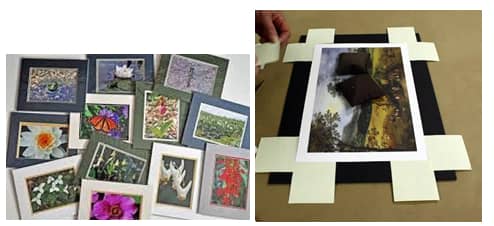
Mounting Artwork
Window mounting using conventional and unconventional surfaces.
Mounting Art Using A Conventional Surface
- Identify and select your paper. Ensure the paper is strong to withstand the weight of your artwork.
- Select the artwork that they would like to mount.
- Use a blade or pair of scissors to trim and cut the edges of the artwork so that they are neat and straight.
- Creating the window place artwork on the mounting surfaces and mark at the edges as illustrated.
Place other marks inside from the first set of marks that you had made. Make sure they are just inside enough not to cover any important part of the artwork as shown. - Draw a margin around the second set of marks that you have made, then cut the margin line you have drawn. This will create a window on the mounting surface. The window should be slightly smaller than the artwork to be mounted.
- Flip the mounting surface on the reverse side then apply adhesive along the window space as shown.
- Fix the artwork using glue on each mounting surface and press it firmly in place as shown.
Mounting Artwork Using Unconventional Surface Procedure
- Identify an old fabric and cartons from the environment. Ensure the fabric is larger than the carton by at least 5 cm on each side by measurement.
- Select the artwork that they would like to mount
- Use a blade or pair of scissors to trim and cut the edges of the artwork so that they are neat and straight.
- Create the window on the carton surface.
- Apply glue on their cut-out window and attach it to the fabric as shown.
- Draw marks at the four corners and two diagonal lines across the window as shown below. Using scissors, trim off the small square marks at each of the four corners. Cut through the diagonal lines you made using a sharp blade then apply glue on the carton.
- Start by folding the outer flaps of the fabric to cover the carton as shown. Then fold the middle pieces fabric over to completely cover the carton.
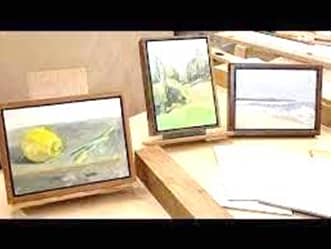
- Apply glue on the created window frame then attach the artwork.
Exhibition Skills - 2d And 3d Artwork Exhibition.
- To a greater extent and exhibition is a culmination of artwork done over a period of time.
- To exhibit is to display items so that they are clearly seen by others. The main reason for exhibiting items are to enable people to have a clear view of the items, appreciate and admire them and also to buy the item.
Exhibition Skills
Skills required to exhibit include:
- Use of space
- Placement of the artwork
- Colour and contrast of background
- Labelling of 2D and 3D artwork.
Design Mixed Media and Technology Graphic Design - CBC Grade 5 Art and Craft Revision Notes
Letter Construction
- Graphic design is the art of combining words and pictures to pass a message.
- Roman letters are letters based on the Roman alphabet. E.g. A B C D E F G H
- Block letters refers to straight letters constructed individually, with no letters joining.
- 3 Dimensional - this is having length, height and depth. Raised from the surface.
Construction Of 3 Dimensional Letters
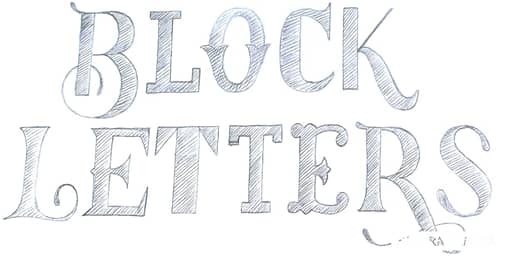
- Draw guidelines in the drawing book using a ruler and a pencil
- Write the alphabetical letters using a pencil.
- Draw an outline around using freehand or a ruler. Rub the inner lines after drawing the outline. These will now be two dimensional letters.
- Draw small projected lines to represent the shadows as they would appear. They can choose to use freehand or a ruler.
- Connect the ends of the projected lines using freehand or with a ruler. Practice constructing simple words like Baraka, Pendo, Amani, NEEMA
Decorating 3 Dimensional roman letters
- Decide on the decoration method to use.
- Prepare or acquire the tools and materials
- Decorate the face of the letters
- Decorate the shadow
- Finish by erasing any unwanted pencil marks
Book Craft
Book jacket - is a removable cover made of paper used to protect the cover of a book A book jacket contains the following:
- Illustration - which is a picture showing what the book is about.
- Author - this is the writer of the book
- Title of the book.
Measuring and cutting the book jacket
- Place the book on the manila paper to get the right measurement.
- Draw the measurement on the book jacket on the hard paper then trim off the excess paper. Mark the flaps, front , spine and back
- Write the title of the book and author’s name on the front cover using block letters.
- Fold out the two flaps and the spine as shown below.
Making the applique and attaching to the book cover
- Applique - decorative designs in which pieces of fabric are sewn or stuck on to a large piece of fabric to form a picture or pattern.
- The following are the steps to decorate the book jacket with applique
- Make a sketch design that goes with the title and then draw their desired shape on a hard paper.
- Cut out the shape and place it on a fabric of their choice.
- Cut out the shape on the fabric
- Place the cut-out shape of fabric on larger fabric.
- Attach the cut out fabric to the larger fabric using running stitches.
- Arrange the beads on the fabric to see how they fit.
- Apply glue on the beads, then rearrange the beads on the fabric and allow them to dry.
- Use glue to attach the applique onto the book jacket and allow it to dry before folding.
Puppetry
- It is the art of making and manipulating puppets in a performance. A puppet is a toy or figure in the shape of a human or animal that is moved by a human to make them appear like they are alive.
- There are several types of puppet. They include:
- Glove puppets
- Stick and rod puppets
- Marionettes
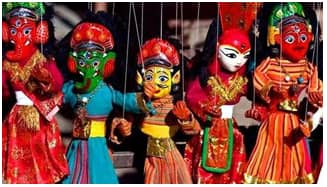
Marionettes
- A marionette is a toy of a person or animal, controlled from above by strings attached to its movable body parts.
- Marionettes are used as characters in performances in entertainment. The person manipulating a marionette is known as a marionettist. They may be hidden or seen by the audience.
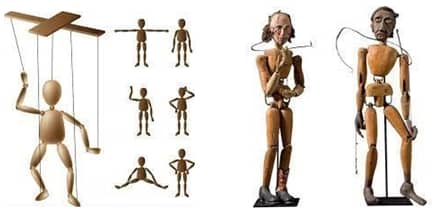
- A marionette has 3 parts
- Model - thi is the main puppet that may be of human or animal figure with movable body parts.
- Handle - this is the part the puppeteer uses to control the marionette. The most common one is a horizontal bar with others attached to it at right angle it is connected to the marionette using strings.
- Strings - these are attached from the handle to different body parts of the marionette. They are used to control the movement of the body parts during a performance.
- A marionette can be made from different materials ranging from wood, cloth, paper and even clay. The main techniques of making a marionette are construction and assemblage.
Making a marionette
- Draw and colour the full figure of the puppet on paper as they would want it to look like.
- Collect pieces of timber for each part of the body, two arms, two legs, the main body section and the head. The pieces should look very close to the parts of the body to minimize carving.
- Measure each piece of timber according to the body part it will form.
- Cut and carve using a knife or adze the piece of timber to look like the parts of the body. Follow the steps they used while carving the cooling stick or ladle in sculpture.
- Assemble the carved pieces by laying out the torso piece down first, then arrange the arms and legs on the marionette so that a section of each overlaps with the torso (the trunk or the part of the human body that doesn’t include the head, arms or leg) piece.
- Creating the joints and dressing the puppet: drill holes using nails or any sharp object and push a wire through each joint in the pupper as shown. The joints should remain loose and flexible enough for the limbs to move easily.
- Dressing the puppet. Sew simple clothing, dress the puppet and attach other details such as the hair using sound materials and objects such as buttons or seed to fix eyes.
- Creating the handle or control bar - lay down two sticks or pencils to form a cross. Tie the sticks together where they intersect using strong strings.
- Attaching the strings - thread a needle with a string (fishing line is best because it is transparent). Know and cut the string after making each attachment. The length of the string extending from each section needs to be long enough to reach the sticks.
- Connecting the strings - knot the fishing line extending from the puppet’s shoulders to the centre of the cross. Knot each of the four strings connected to the puppet’s limbs to an individual arm of the cross.
- Perform for a friend to test the marionette by manipulating the control bars at intervals.
Photography
- Photography is the art of taking pictures with a camera. Cameras range from digital camera and mobile phone camera.
- In photography certain elements needs to be taken into consideration. They include:
Focus
which includes: background, image quality, center of interest viewpoint, 3 views perspective lightning.
Focus is very important in photography. A focused image is sharp and clear. It involves adjusting the camera lens and the distance from the subject, that is the object being photographed. In digital cameras this can be done automatically
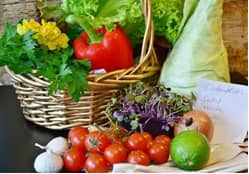

Background
refers to what is behind the main subject being photographed.
Choose a background that will make the subject stand out
tell where the background is standing out Image quality - refers to the sharpness and the brightness of a photograph.
Make sure your photograph is well focused, hold your camera firmly to avoid shaking. Take time until the image looks clear on the screen.
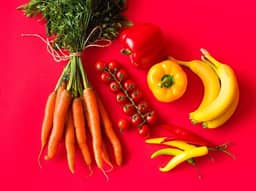
Centre of interest - is the most outstanding part or object in a photograph.
Choose one center of interest where possible. This should be the main subject in the picture.
No centre of interest
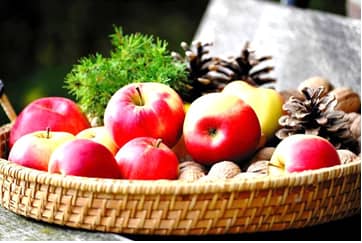
Clear Centre of interest
Viewpoint - in photography or point of view is the position of the camera in relation to that of the subject being photographed.
There are three most common points of seeing objects. These are
When the camera is at the same level with what is being photographed. This is called Eye level.
When the camera is above what is being photographed. This is called Bird’s eye view.
The camera can be below what is being photographed and that is called Worm’s eye view.
Lighting - lighting is important in photography as you cannot see without light.
One should consider the following when taking your photographs.
- Avoid bright light behind your subject
- Avoid very dark shadows
- Where possible avoid taking photographs when the sun is very bright like at noon. Mornings and evenings have better light for taking photography.
- Framing (placement of forms within the frame)
Framing is the placement of forms within the photograph.
- Choose the object to include in the picture carefully making sure the subject is clearly seen and well placed within the frame.
- The main subject of the photograph should be the center of interest.
- Avoid having too many objects in the photograph.
- composition
This refers to making something by arranging several things to form a whole. The composition of your photograph is done by combining different things to make the whole photograph.
These includes the lines, shapes and object such as people or animals





